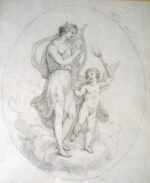Terpsichore
Guide Price: £1,250
Make An OfferPencil and ink on laid paper; 10 ½ by 9 in; 26.5 x 23 cm; framed
Provenance: William Drummond - Covent Garden Gallery; An important private collection, England
With thanks to Neil Jeffares for his help in cataloguing this work.
The Nine Muses of Greek Mythology were daughters of Mnemosyne and Zeus; deities that gave artists and philosophers the necessary inspiration for creation. The Greek poet Hesiod reveals that they were called Muses as the Greek word “mosis” refers to desire and wish; the word museum also derives from this. All the ancient writers appeal to the Muses at the beginning of their works; Homer asks them in both the Iliad and Odyssey to help him tell the story in the most proper way, and even today they are recognised as symbols of inspiration and artistic creation.
In painting the Muses are usually presented as ethereal women with divine beauty, holding laurels and other items depending on their faculty. Terpsichore was one of the nine muses, the goddesses of music, song and dance. In late classical times, when the Muses were assigned specific literary and artistic spheres, Terpsichore was named Muse of choral song and dancing, and represented with a plectrum and lyre.
In the intriguing sketch presented here she is shown inspiring Eros, who holds aloft a torch denoting the eternal flame of love and desire. It relates directly to an engraving by Francesco Bartolozzi after a work by Giovanni Cipriani published in 1779. The linear nature of the work, ink drawn finely over pencil, implies this is a sketch used for engraving purposes. In this instance there are small differences in the composition to that published but it shows strong similarlities to works by Bartolozzi and as such this could be the preliminary sketch made by him from Cipriani’s original work. The highly respected and knowledgeable art dealer William Drummond in the 1980s considered it was an autograph work by him.



